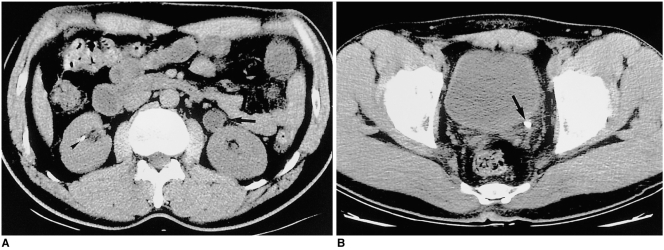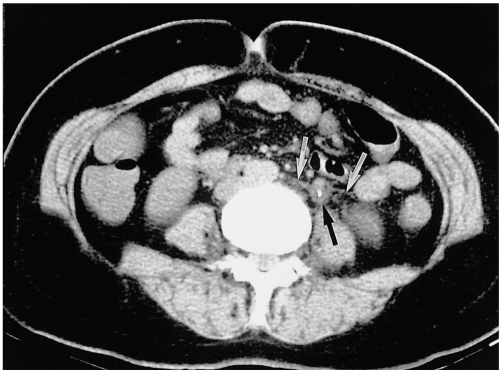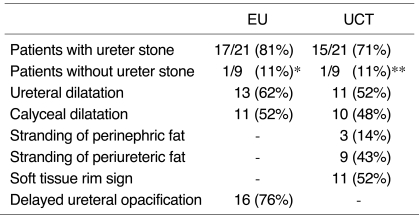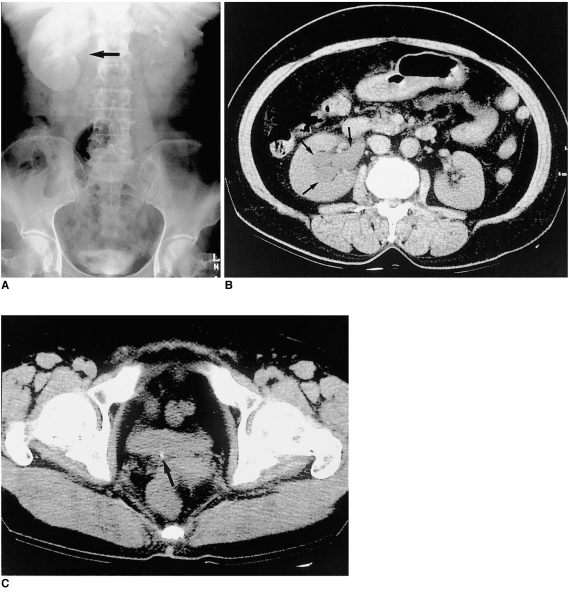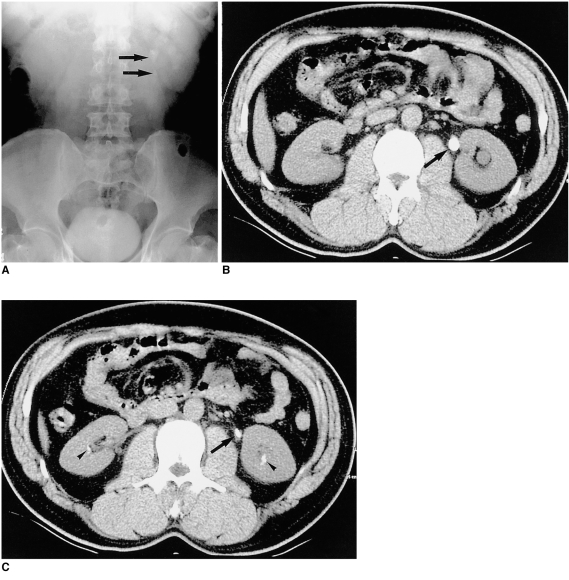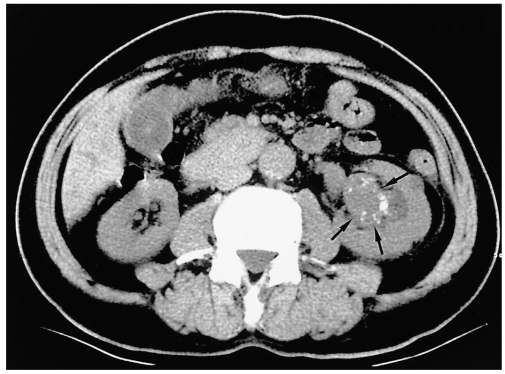Abstract
Objective
To compare the usefulness of unenhanced spiral CT (UCT) with that of excretory urography (EU) in patients with acute flank pain.
Materials and Methods
Thirty patients presenting with acute flank pain underwent both UCT and EU. Both techniques were used to determine the presence, size, and location of urinary stone, and the presence or absence of secondary signs was also evaluated. The existence of ureteral stone was confirmed by its removal or spontaneous passage during follow-up. The absence of a stone was determined on the basis of the clinical and radiological evidence.
Results
Twenty-one of the 30 patients had one or more ureteral stones and nine had no stone. CT depicted 22 of 23 calculi in the 21 patients with a stone, and no calculus in all nine without a stone. The sensitivity and specificity of UCT were 96% and 100%, respectively. EU disclosed 14 calculi in the 21 patients with a stone and no calculus in eight of the nine without a stone. UCT and EU demonstrated secondary signs of ureterolithiasis in 15 and 17 patients, respectively.
Conclusion
For the evaluation of patients with acute flank pain, UCT is an excellent modality with high sensitivity and specificity. In near future it may replace EU.
Keywords: Unenhanced CT; Excretory urography; Ureter, stone
In the fields of emergency medicine and urology, acute flank pain is a common clinical problem. Urolithiasis, for example, is reported to affect up to 12% of the population during their lifetime (1). Traditionally, excretory urography (EU) has been the gold standard method of diagnosing this condition, but particularly in cases with urinary obstruction the time required for the procedure is relatively long, and this may cause prolonged pain and discomfort. In addition, the intravenous injection of contrast material is required, and this carries the risk of life-threatening side effects.
For patients with suspected acute ureteral colic, unenhanced spiral CT (UCT) is an attractive alternative. The procedure lasts only a very short time and causes no discomfort. In addition, it can be used for patients who are allergic to contrast media or who suffer renal insufficiency. The utility of UCT in evaluating patients with acute ureteral colic has been frequently reported in the literature in English (2-18); in our country, however, no such investigation has been documented. The purpose of this study was to evaluate the usefulness of UCT in patients with acute flank pain by prospectively comparing UCT with EU, and to determine whether, in our clinical setting, UCT can replace EU in the diagnosis of urolithiasis.
MATERIALS AND METHODS
Between 1 May and 31 July 2000, thirty patients presenting with acute flank pain and in whom ureterolithiasis was suspected participated in this study. The presence or absence of ureteral stone was confirmed by the passage of stones, either spontaneously or following extracorporeal shock wave lithotripsy (ESWL), by ureteroscopic stone removal, and/or by follow-up imaging studies. After informed consent, the 30 enrolled subjects successively underwent UCT and EU. For UCT, a High-Speed Advantage CT scanner (General Electric, Milwaukee, Wis., U.S.A.) was used to obtain transverse scans from the top of the kidneys to the symphysis pubis. The settings were 5 mm collimation, 1.5:1 pitch, 120 kVp, and 220-260 mA. EU images were obtained 5, 15 and 25 minutes after the administration of 30 cc of non-ionic contrast medium (Iopamiro; Bracco, Milano, Italy). If the renal pelvocalyceal system or ureter was not observed during routine EU examination, delayed radiographs were obtained after an appropriate interval. UCT was performed within 24 hours of the onset of symptoms, and EU within six hours of UCT. For image analysis, two radiologists [RJA, KB] first independently interpreted the UCT and EU findings for the presence or absence of ureteral stones, and final decisions were reached by consensus. UCT and EU imaging findings of urolithiasis, including size and location, were analyzed and compared between the 'stones detected' and 'stones undetected' group. The presence or absence of secondary signs of ureterolithiasis and associated findings outside the urinary tract were also analyzed. Secondary signs included the presence of delayed nephrogram, or ureteral or pelvocalyceal dilatation in comparison with the contralateral side, as seen on EU, and ureteral dilatation, soft tissue rim sign, or perinephric or periureteral stranding, as seen on UCT. The sensitivity, specificity, positive and negative predictive values and accuracy of both UCT and EU were calculated.
RESULTS
Of the 30 patients, 21 were confirmed as having one or more ureteral stones, while nine had no stone. Eighteen of the 21 underwent subsequent intervention such as extracorporeal shock wave lithotripsy (ESWL) or ureteroscopic stone removal, while in three, stones passed spontaneously.
UCT depicted 22 of 23 calculi in the 21 patients with a stone and no calculus in the nine without a stone. The sensitivity and specificity of UCT were 96% and 100%, respectively. EU disclosed 14 of 23 calculi among the group of 21, and no calculus in eight of the nine without a stone. The remaining patient was falsely diagnosed on EU as having a radiolucent stone, while UCT correctly diagnosed the absence of a calculus in the ureter. The sensitivity and specificity of EU were 61% and 89%, respectively.
UCT and EU demonstrated secondary signs of ureterolithiasis in 15 and 17 patients, respectively (Figs. 1, 2). The relative incidences of individual secondary signs, as seen on UCT and EU, are shown in Table 1. While dilatation of the ureter and pelvocalyceal system was revealed by both modalities, functional assessment such as delayed ureteral opacification and dense persistent nephrogram were demonstrated only by EU (Fig. 3).
Fig. 1.
A 43-year-old patient with acute flank pain.
A, B. Transaxial scans through the kidneys and bladder, respectively. Dilatation of the left renal pelvis (arrow in A) and a left distal ureter stone (arrow in B) are seen. Arrowhead: right renal calyceal stone.
Fig. 2.
A 46-year-old man with acute flank pain. A transaxial CT scan through the lower poles of the kidneys demonstrates soft tissue rim sign around the ureter stone (black arrow) and periureteral strand in adjacent fat tissue (white arrows).
Table 1.
Relative Incidences of Secondary Signs of Ureterolithiasis. The numbers of Patients with or without Ureter Stone are Also Stated.
*One patient with a renal stone showed delayed nephrogram.
**One patient with transitional cell carcinoma showed perinephric stranding.
EU: excretory urography; UCT: unenhanced spiral computed tomography
Fig. 3.
A 57-year-old woman with acute right flank pain.
A: EU; B, C: Transaxial UCT scans through the kidneys and bladder. A dense delayed nephrogram is seen in A, but the entire EU study revealed no stone shadow. On UCT a tiny stone at the right ureterovesical junction (arrow in C) is seen along with dilatation of the renal pelvocalyceal system (arrows in B).
In the 21 patients with 23 ureteral calculi, the calculus was located at the ureteropelvic junction in one patient, in the proximal, mid and distal ureter in seven, one, and nine patients, respectively, and at the ureterovesical junction in five. The size of the stones ranged from 2 to 16 (average, 5.7) mm.
The stone that was missed on EU was located in the proximal ureter in three patients, the distal ureter in three, and at the ureterovesical junction in the other three. The size of these stones ranged from 2 to 8 (average, 3.9) mm. Among these nine patients, secondary signs were disclosed by EU in six.
In one patient UCT failed to demonstrate two consecutive ureteral stones whereas EU accurately depicted two separate stones (Fig. 4). On UCT they were seen as one elongated stone. Conversely, in another patient, EU missed one of two distal ureter stones, both of which were clearly depicted by UCT (Fig. 5).
Fig. 4.
A 45-year-old male patient with acute flank pain.
A: EU; B, C: UCT. Two separate stones (arrows) are demonstrated in the left proximal ureter in A, but on UCT (B, C) they are seen as one elongated stone. UCT (C), however, demonstrates small renal stones (arrowheads), not seen in A, at the lower pole of the left kidney.
Fig. 5.
A 53-year-old man with acute flank pain.
A: EU; B, C: Two consecutive CT scans of the pelvis. A single stone is seen in the left distal ureter in A; UCT, however, clearly demonstrates two separate distal ureter stones (white arrows) in B and C. The smaller stone in the more distal ureter, seen in C, is obscured in A.
In three patients renal stones were also seen on UCT. Incidental findings outside the urinary tract included a calcified renal pelvic tumor in one patient (Fig. 6) and a gallstone in another.
Fig. 6.
Incidentally discovered transitional cell carcinoma of the left kidney (arrows) in a 72-year-old man who presented with acute flank pain and hematuria.
DISCUSSION
In the evaluation of patients with acute flank pain the diagnosis is often suggested by clinical history, physical examination, and laboratory findings. For the diagnosis of urolithiasis, imaging studies such as plain radiography (KUB) or EU are essential. The sensitivity of KUB, however, is known to be low, only about 45 to 60% (2, 3, 19, 20), and due to overlying fecal materials or bowel gas it is sometimes difficult to diagnose ureteral stones and to differentiate them from mesenteric or vascular calcifications. Although EU has been used as a standard method for the diagnosis of ureteral stones, it uses iodinated contrast medium and this may cause life-threatening side effects. In addition, the time required is often relatively long (greater than 30 minutes), particularly in cases of obstruction, and this will increase both patient discomfort and exposure to radiation. The sensitivity of EU, however, has been reported as 84-95% (20, 21).
Since 1995, UCT has been used for the evaluation of patients with acute flank pain (4), and has been reported to be more effective than EU, with a sensitivity of about 96-100%. Using spiral CT, the whole study can be completed within one breath hold (5). UCT can visualize all calciumcontaining stones, including uric acid or cystine calculi, and some indinavir stones in HIV patients, all of which plain radiography or EU reveals only with difficulty (5). Secondary signs such as ureteral or calyceal dilatation, perinephric or periureteral stranding, and the soft tissue rim sign are helpful for the diagnosis of ureterolithiasis.
In this study, UCT depicted all ureter stones except one that was located immediately next to a larger stone in the left upper ureter, a detection rate much higher than that of EU (61%). Secondary signs were seen on UCT in 71% of patients, and on EU in 81%. These results are comparable to those of recently published studies which reported the sensitivity of UCT as 67-97% and its specificity as 90-93% (6, 7).
The presence of the tissue rim sign has been reported in 50-77% of patients with ureteral stones (8, 9). In our study it was present in 11/21 such patients (51%). Ureteral and calyceal dilatation were seen in 52% and 48% of our patients, respectively, figures which are also comparable to those of earlier studies (8, 9). Other signs such as nephromegaly and perinephric or periureteral stranding were less frequent in our study than in previous ones (10).
One of the most important advantages of UCT is its short scan time and the fact that there is thus less patient discomfort. In our study, scanning took only 40-50 seconds and no additional scan was needed. The room time for UCT has been reported to be one-third to one-quarter of that required for routine EU (14, 15). The reformatted image can be helpful for communication with the clinician but further increases in sensitivity or specificity have not been reported (16).
Multidetector-array (MDA) CT scanning, which uses thinner section slices of up to 1.25 mm and a faster table speed of 3.75 to 30.00 mm/rotation, has been reported to detect a larger number of lesions than conventional CT, as well as increasing diagnostic confidence (22, 23). A recent report stated that unenhanced MDA helical CT increased the detection rate of ureterolithiasis (24); to further investigate the usefulness of MDA CT in patients with this condition, a well-designed prospective study is required.
Another advantage of UCT is its ability to provide alternative diagnosis for acute flank pain (11-13). In our study one patient had a calcified renal pelvic mass, proven to be transitional cell carcinoma. Kidney stones and gallstones were each seen in three cases.
A disadvantage of UCT is the higher radiation dosage which may be involved: an early study reported that this was about three times that of EU (17). In that report, however, EU was three-shot and the increased dosage of delayed films was not taken into account. In several other recent studies, UCT and EU were reported to emit similar amounts of radiation (2, 13, 14, 18), and helical CT is known to emit a lower gonadal dose than EU (13, 14).
It has been reported in the United States that in evaluating patients with acute flank pain, UCT is cost effective (5, 14). Although its cost there is about 1.5 times more than that of EU, it can also demonstrate other pathological conditions, outside the urinary tract, and thus may reduce additional cost. In our country, the higher cost of UCT (about twice that of EU) can be an obstacle against its wider use in the evaluation of patients with acute ureteral colic. Because of the shorter scan time, reduced patient discomfort, and the possibility of additional diagnosis, however, the clinical use of UCT for the diagnosis of ureterolithiasis may increase.
Our study suffers from several limitations. First, patients were selected by a clinician (JSS) who tried to include equivocal rather than merely straightforward cases. Patients with ureteral stone thus comprised only two-thirds of our study population, and this may have caused selection bias and influenced the results of our study. Second, in a few patients there was some delay between UCT and EU. This was not more than six hours, however, and no patient experienced the passage of a stone during this period.
In conclusion, UCT is highly sensitive and specific in the depiction of ureteral stones, and is an excellent modality for evaluating patients with acute ureteral colic. In the near future it may replace EU in the evaluation of patients with acute flank pain.
References
- 1.Sierakowski R, Finlayson B, Landes RR, et al. The frequency of urolithiasis in hospital discharge diagnoses in the United States. Invest Urol. 1978;15:438–441. [PubMed] [Google Scholar]
- 2.Miller OF, Rineer SK, Reichard SR, et al. Prospective comparison of unenhanced spiral computed tomography and intravenous urogram in the evaluation of acute flank pain. Urology. 1998;52:982–987. doi: 10.1016/s0090-4295(98)00368-9. [DOI] [PubMed] [Google Scholar]
- 3.Levine JA, Neitlich J, Verga M, Dalrymple N, Smith RC. Ureteral calculi in patients with flank pain: correlation of plain radiography with unenhanced helical CT. Radiology. 1997;204:27–31. doi: 10.1148/radiology.204.1.9205218. [DOI] [PubMed] [Google Scholar]
- 4.Smith RC, Ronsenfield AT, Choe KA, et al. Acute flank pain: comparison of non-contrast-enhanced CT and intravenous urography. Radiology. 1995;194:789–794. doi: 10.1148/radiology.194.3.7862980. [DOI] [PubMed] [Google Scholar]
- 5.Miller OF, Kane CJ. Unenhanced helical computed tomography in the evaluation of acute flank pain. Curr Opin Urol. 2000;10:123–129. doi: 10.1097/00042307-200003000-00013. [DOI] [PubMed] [Google Scholar]
- 6.Dalymple NC, Verga M, Anderson KR, et al. The value of unenhanced helical computed tomography in the management of acute flank pain. J Urol. 1998;159:735–774. [PubMed] [Google Scholar]
- 7.Smith RC, Verga M, McCarthy S, Rosenfield AT. Acute ureteral obstruction: value of secondary signs of helical unenhanced CT. AJR. 1996;167:1109–1113. doi: 10.2214/ajr.167.5.8911160. [DOI] [PubMed] [Google Scholar]
- 8.Heneghan JP, Dalrymple NC, Verga M, Rosenfield AT, Smith RC. Soft tissue "rim" sign in the diagnosis of ureteral calculi with use of unenhanced helical CT. Radiology. 1997;202:709–711. doi: 10.1148/radiology.202.3.9051021. [DOI] [PubMed] [Google Scholar]
- 9.Kawashima A, Sandler CM, Boridy IC, et al. Unenhanced helical CT of ureterolithiasis: value of the tissue rim sign. AJR. 1997;168:997–1000. doi: 10.2214/ajr.168.4.9124157. [DOI] [PubMed] [Google Scholar]
- 10.Boridy IC, Nikloaidis P, Kawashima A, Sandler CM, Goldman SM. Noncontrast helical CT for ureteral stones. World J Urol. 1998;16:18–21. doi: 10.1007/s003450050020. [DOI] [PubMed] [Google Scholar]
- 11.Boulay I, Holtz P, Foley WD, White B, Begun FP. Ureteral calculi: diagnostic efficacy of helical CT and implications for treatment of patients. AJR. 1999;172:1485–1490. doi: 10.2214/ajr.172.6.10350277. [DOI] [PubMed] [Google Scholar]
- 12.Niall O, Russel J, McGregor R, Duncan H, Mullins J. A comparison of noncontrast computed tomography with excretory urography in the assessment of acute flank pain. J Urol. 1999;161:534–537. [PubMed] [Google Scholar]
- 13.Fielding JR, Steele G, Fox LA, Heller H, Loughlin KR. Spiral computed tomography in the evaluation of acute flank pain: a replacement for excretory urography. J Urol. 1997;157:2071–2073. [PubMed] [Google Scholar]
- 14.Chen MYM, Zagoria RJ. Can noncontrast helical computed tomography replace intravenous urography for evaluation of patients with acute urinary tract colic? J Emerg Med. 1999;17:299–303. doi: 10.1016/s0736-4679(98)00166-8. [DOI] [PubMed] [Google Scholar]
- 15.Yilmaz S, Sindel T, Arslan G, et al. Renal colic: comparison of spiral CT, US and IVU in the detection of ureteral calculi. Eur Radiol. 1998;8:212–217. doi: 10.1007/s003300050364. [DOI] [PubMed] [Google Scholar]
- 16.Sommer FG, Jeffrey RB, Jr, Rubin GD, et al. Detection of ureteral calculi in patients with suspected renal colic: value of reformatted noncontrast helical CT. AJR. 1995;165:509–513. doi: 10.2214/ajr.165.3.7645461. [DOI] [PubMed] [Google Scholar]
- 17.Denton ERE, Mackenzie A, Greenwell T, Popert R, Rankin SC. Unenhanced helical CT for renal colic: is the radiation dose justifiable? Clin Radiol. 1999;54:444–447. doi: 10.1016/s0009-9260(99)90829-2. [DOI] [PubMed] [Google Scholar]
- 18.Vieweg J, Teh C, Freed K, et al. Unenhanced helical computed tomography for the evaluation of patients with acute flank pain. J Urol. 1998;160:679–684. doi: 10.1016/S0022-5347(01)62754-X. [DOI] [PubMed] [Google Scholar]
- 19.Svedstrom E, Alanen A, Nurmi M. Radiologic diagnosis of renal colic: the role of plain films, excretory urography and sonography. Eur J Radiol. 1990;11:180–183. doi: 10.1016/0720-048x(90)90051-c. [DOI] [PubMed] [Google Scholar]
- 20.Mutgy A, Williams JW, Nettleman M. Renal colic: utility of the plain abdominal roentgenogram. Arch Intern Med. 1991;151:1589–1591. doi: 10.1001/archinte.151.8.1589. [DOI] [PubMed] [Google Scholar]
- 21.Saita H, Matsukawa M, Fukushima H, Ohyama C, Nagata Y. Ultrasound diagnosis of ureteral stones: its usefulness with subsequent excretory urography. J Urol. 1987;140:28–31. doi: 10.1016/s0022-5347(17)41476-5. [DOI] [PubMed] [Google Scholar]
- 22.Berland LL, Smith JK. Multidetector-array CT: Once again, technology creates new opportunities. Radiology. 1998;209:327–329. doi: 10.1148/radiology.209.2.9807555. [DOI] [PubMed] [Google Scholar]
- 23.Hu H, He HD, Foley WD, et al. Four multidetector-row helical CT: image quality and volume coverage speed. Radiology. 2000;215:55–62. doi: 10.1148/radiology.215.1.r00ap3755. [DOI] [PubMed] [Google Scholar]
- 24.Kawashima A, Sandler CM, West O, et al. Detection of ureterolithiasis with unenhanced multidetector-array helical CT: comparison of 2.5-mm and 5.0-mm slice thickness. Radiology. 2000;217(P):223. [Google Scholar]



